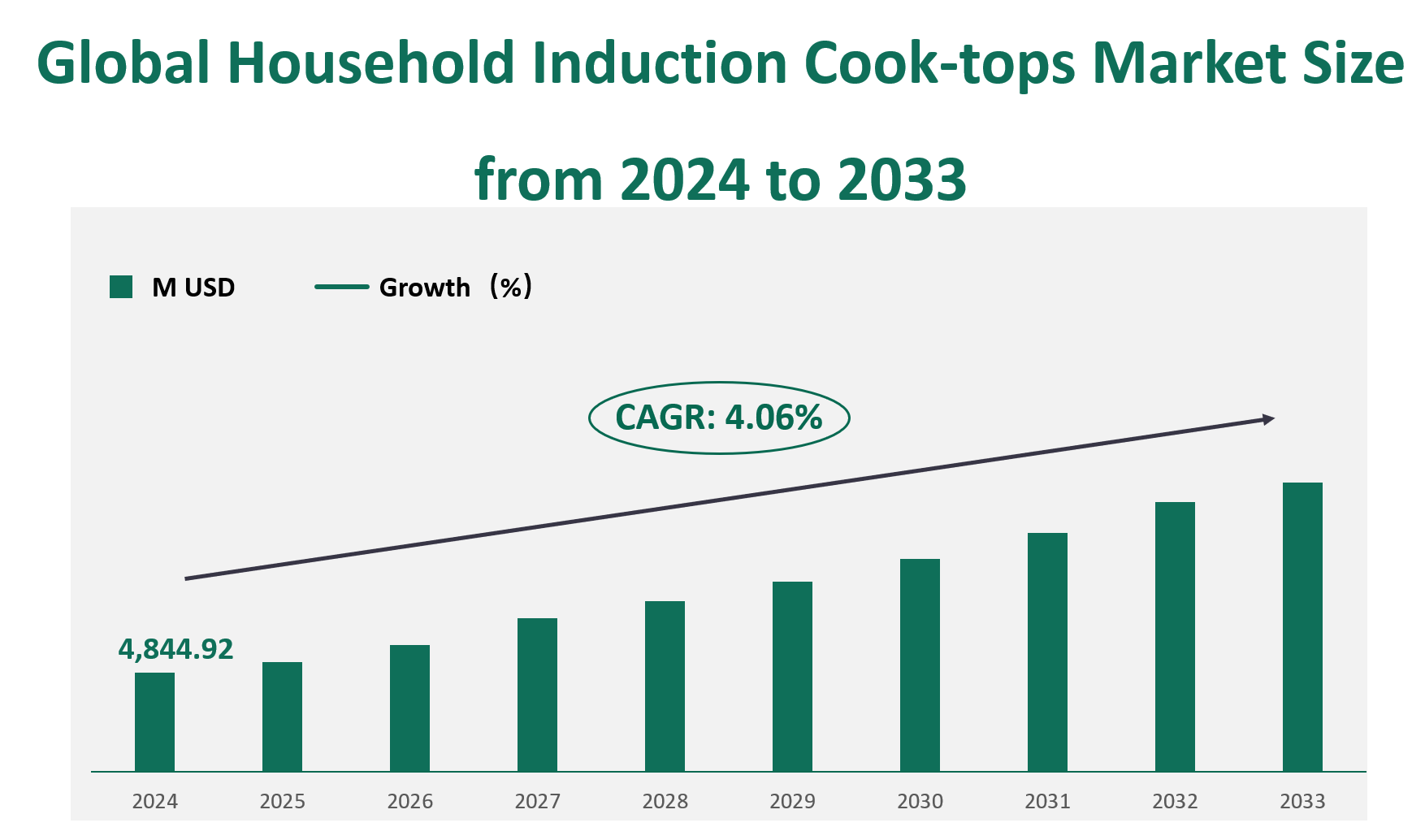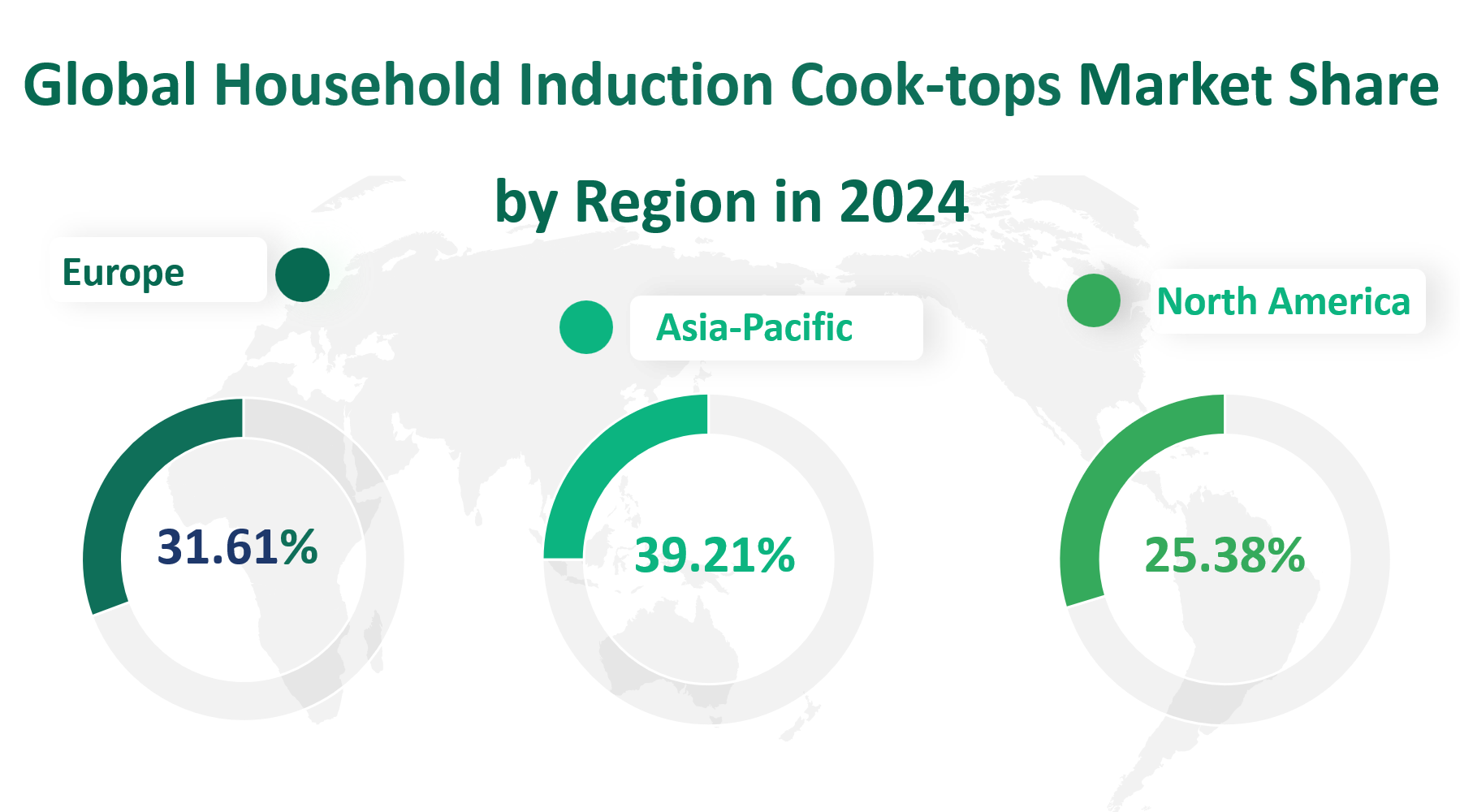1. Global Household Induction Cook-tops Market Insight Analysis
In 2024, the global household induction cook-tops market is projected to reach a value of $4,844.92 million, with a Compound Annual Growth Rate (CAGR) of 4.06% from 2024 to 2033.
The household induction cook-top is a type of kitchen appliance that utilizes electromagnetic field technology to transfer heat directly to ferrous metal cookware. Unlike traditional cooktops, induction cook-tops automatically shut off when no cookware is present, making them safer and more energy-efficient. These appliances are known for their sleek design, ease of cleaning, and ability to cook food more quickly compared to other types of cooktops. The absence of open flames also makes them a popular choice for consumers, especially in households with young children.
Figure Global Household Induction Cook-tops Market Size (M USD) and CAGR (2024-2033)

2. Driving and Limiting Factors of Household Induction Cook-tops Market Growth
The growth of the household induction cook-tops market is driven by several key factors. The increasing popularity of modular kitchens and the rising preference for optimized cooking solutions are significant drivers. As more households seek to maximize kitchen space and efficiency, built-in induction cook-tops become an attractive option. Additionally, the growing awareness about energy-saving and environmental benefits of induction cook-tops is driving consumer interest. The rising working female population in emerging countries and the increasing price of liquefied petroleum gas (LPG) are also contributing to the demand for more efficient cooking appliances.
However, the market faces several challenges. The initial cost of induction cook-tops is relatively high compared to conventional cooking appliances, which may deter some consumers. The need for specialized cookware, such as ferrous metal pots and pans, can also limit market penetration. Additionally, strict regulations and quality standards in various countries can pose barriers to entry for new manufacturers. The rising labor costs in major production regions, such as China and India, are also a concern for manufacturers, as they can increase production costs and impact profit margins.
3. Technology Innovation and Corporate Mergers and Acquisitions in Household Induction Cook-tops Market
Technological innovation is a key driver in the household induction cook-tops market. Manufacturers are continuously developing new features and improving existing technologies to enhance user experience and efficiency. For example, advanced temperature control, multiple cooking zones, and smart connectivity features are becoming more common. These innovations not only improve cooking performance but also align with the growing trend of smart kitchens.
Corporate mergers and acquisitions have also played a significant role in shaping the market. For instance, Midea’s acquisition of German robot maker Kuka in 2016 aimed to enhance manufacturing capabilities and improve factory automation. Whirlpool’s acquisition of Yummly, a recipe search engine, in 2017 was a strategic move to integrate smart technology and improve user engagement. Electrolux’s acquisition of French service provider La Compagnie du SAV (CSAV) in 2021 strengthened its service network and commitment to appliance repairability.
4. Global Household Induction Cook-tops Market Size by Type
Household induction cook-tops have gained significant popularity in recent years due to their energy efficiency, safety features, and ease of use. These cook-tops use electromagnetic fields to transfer heat directly to ferrous metal cookware, making them more efficient and safer compared to traditional gas or electric cook-tops. The market for household induction cook-tops can be segmented into two primary product types: Free Standing & Portable Cooktops and Built-in Cooktops.
Free Standing & Portable Cooktops are designed for flexibility and convenience. These cook-tops can be easily moved from one place to another, making them ideal for households with limited kitchen space or those who prefer to use their cook-tops in different locations. They typically feature sleek designs, easy-to-clean surfaces, and safety features such as automatic shut-off when cookware is removed. According to the market analysis, the sales of Free Standing & Portable Cooktops in 2024 are projected to reach 1,815.89 million USD.
Built-in Cooktops, on the other hand, are designed to be integrated into kitchen countertops, providing a seamless and modern look. These cook-tops are often preferred by consumers who are looking for a more permanent and aesthetically pleasing solution for their kitchens. Built-in Cooktops offer a variety of sizes and configurations, allowing for customization to fit specific kitchen designs. They also provide advanced features such as precise temperature control and multiple cooking zones. The market sales for Built-in Cooktops in 2024 are expected to reach 3,029.03 million USD.
Table Global Household Induction Cook-tops Market Size by Type in 2024
Market Size (M USD) 2024 | Market Share | |
Free Standing & Portable Cooktops | 1815.89 | 37.48% |
Built-in Cooktops | 3029.03 | 62.52% |
5. Global Household Induction Cook-tops Market Size by Application
The household induction cook-tops market can be segmented based on various applications, including Supermarkets/Hypermarkets, Specialty Stores, Online, and Others.
Supermarkets and hypermarkets are traditional retail channels that offer a wide range of household appliances, including induction cook-tops. These stores provide consumers with the opportunity to physically examine and compare different models before making a purchase. The sales of household induction cook-tops through Supermarkets/Hypermarkets in 2024 are projected to reach 1,233.20 million USD.
Specialty stores focus on specific product categories and often provide more detailed information and personalized service to customers. These stores may offer a wider range of high-end and specialized induction cook-tops. The sales through Specialty Stores in 2024 are expected to be 1,405.41 million USD.
The online channel has experienced significant growth in recent years due to the increasing penetration of the internet and the rise of e-commerce platforms. Online retailers offer a vast selection of products, competitive prices, and the convenience of shopping from home. The sales of household induction cook-tops through online channels in 2024 are projected to reach 2076.12 million USD.
Table Global Household Induction Cook-tops Market Size by Application in 2024
Application | Market Size (M USD) 2024 | Share |
Supermarkets/Hypermarkets | 1233.20 | 25.45% |
Specialty Stores | 1405.41 | 29.01% |
Online | 2076.12 | 42.85% |
Others | 130.19 | 2.69% |
6. Global Household Induction Cook-tops Market by Top Regions
North America, encompassing the United States and Canada, is a significant market for household induction cook-tops. The region is characterized by high consumer awareness of energy-efficient appliances and a preference for modern kitchen designs. In 2024, the market size for household induction cook-tops in North America is projected to reach 1,229.42 M USD.
Europe is another major market, driven by a high demand for energy-efficient and technologically advanced appliances. European consumers often prioritize quality and design, making this region a key market for high-end induction cook-tops. In 2024, the European market is expected to generate 1,531.36 M USD in revenue.
The Asia-Pacific region is the largest and fastest-growing market for household induction cook-tops. This region includes countries like China, Japan, South Korea, India, and Australia, which have seen rapid economic growth and urbanization. The market size in 2024 is projected to reach 1,899.54 M USD.
Latin America, comprising countries like Mexico, Brazil, and Argentina, is a growing market for household induction cook-tops. The region’s market size in 2024 is expected to be 108.68 M USD.
The Middle East and Africa region is also experiencing growth in the household induction cook-tops market. The market size in 2024 is projected to be 75.93 M USD.
Figure Global Household Induction Cook-tops Market Size by Region in 2024

7. Global Household Induction Cook-tops Market Analysis by Major Players
7.1 Midea
Introduction and Business Overview
Midea Group Co. Ltd., established in 1968, is a leading Chinese manufacturer of household electrical appliances. The company is headquartered in Guangdong, China, and operates manufacturing plants primarily in Asia. Midea offers a wide range of products, including refrigerators, air conditioners, washing machines, and induction cook-tops. The company is known for its innovative products and strong market presence.
Products Offered
Midea offers a variety of household induction cook-tops, including models with advanced features such as precise temperature control, multiple cooking zones, and sleek designs. Their induction cook-tops are designed to be energy-efficient and easy to use, making them popular among consumers.
7.2 Whirlpool
Introduction and Business Overview
Whirlpool Corporation, founded in 1911, is a global leader in home appliances. Headquartered in the United States, Whirlpool operates manufacturing plants in Europe, Asia, and America. The company offers a wide range of products, including laundry appliances, refrigerators, cooking appliances, and induction cook-tops. Whirlpool is known for its high-quality products and strong brand presence.
Products Offered
Whirlpool offers a variety of induction cook-tops, including built-in models with advanced features such as precise temperature control, multiple cooking zones, and sleek designs. Their induction cook-tops are designed to be energy-efficient and easy to use, making them popular among consumers.
7.3 Electrolux
Introduction and Business Overview
Electrolux AB, established in 1919, is a leading global appliance company headquartered in Sweden. The company operates manufacturing plants in Europe, Asia, and America and offers a wide range of products, including refrigerators, dishwashers, washing machines, and induction cook-tops. Electrolux is known for its high-quality products and strong brand presence.
Products Offered
Electrolux offers a variety of induction cook-tops, including built-in models with advanced features such as precise temperature control, multiple cooking zones, and sleek designs. Their induction cook-tops are designed to be energy-efficient and easy to use, making them popular among consumers.

